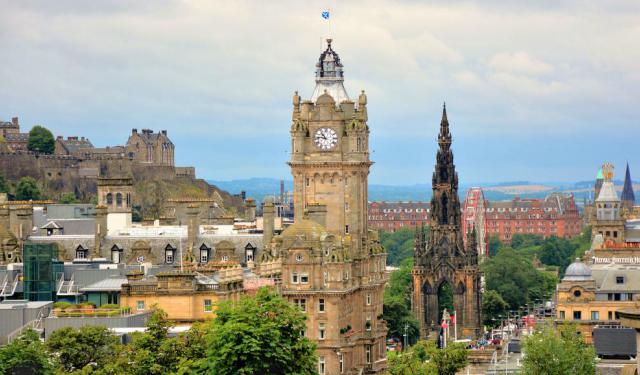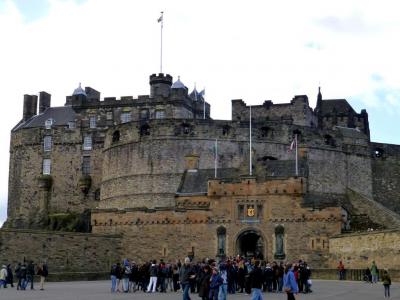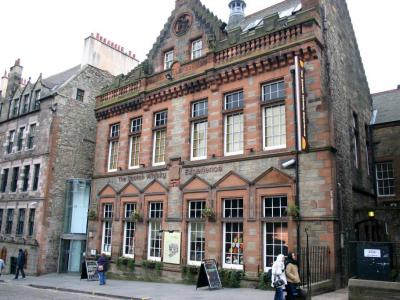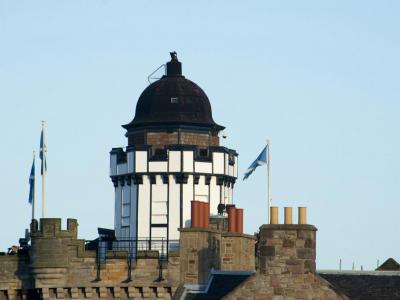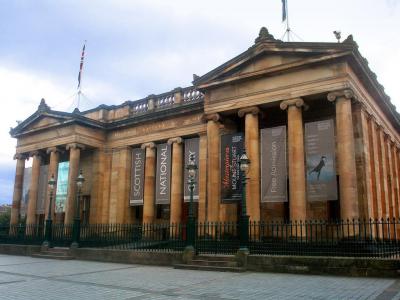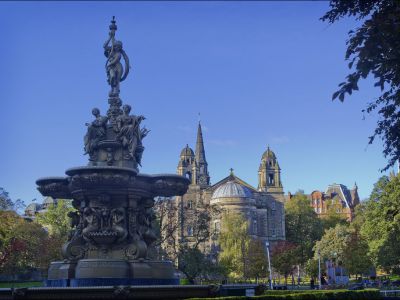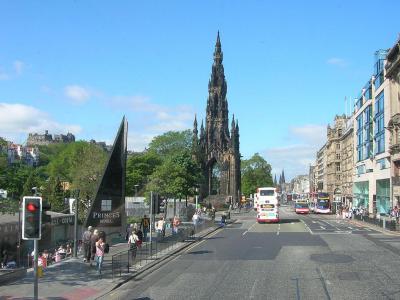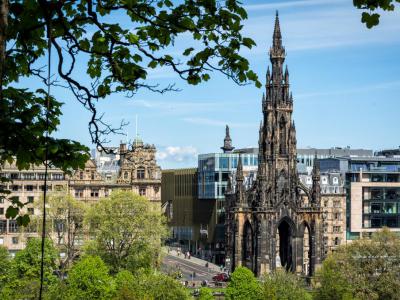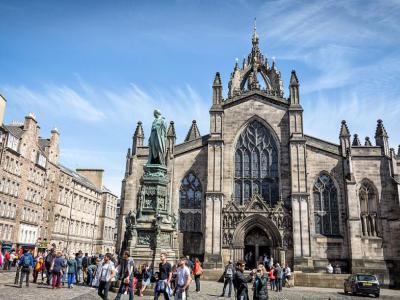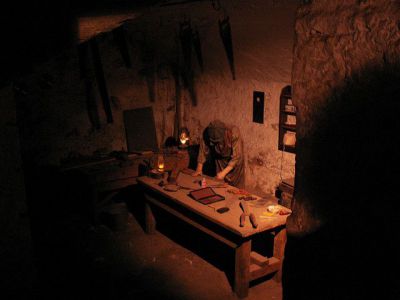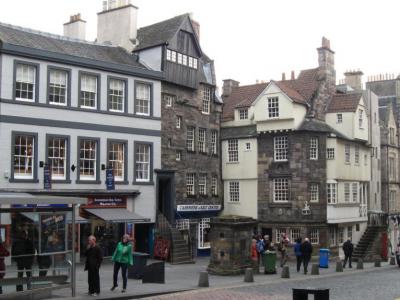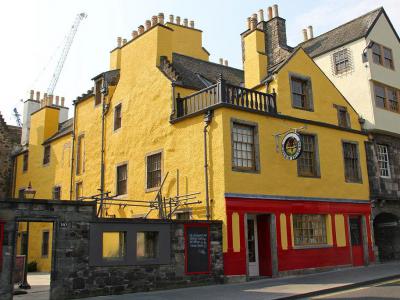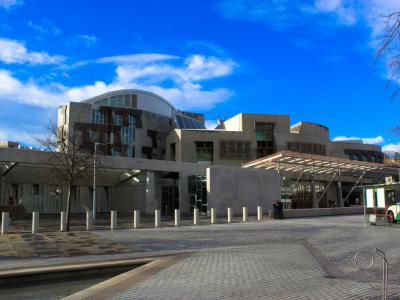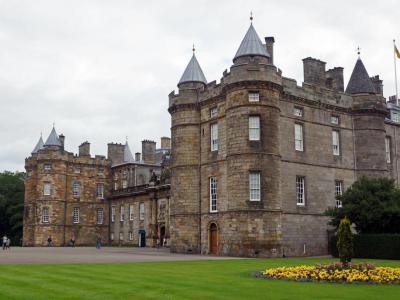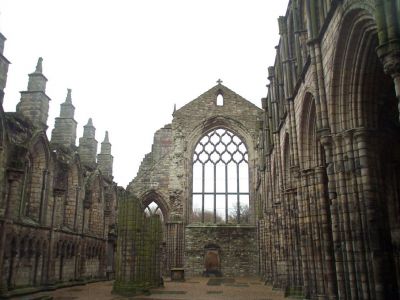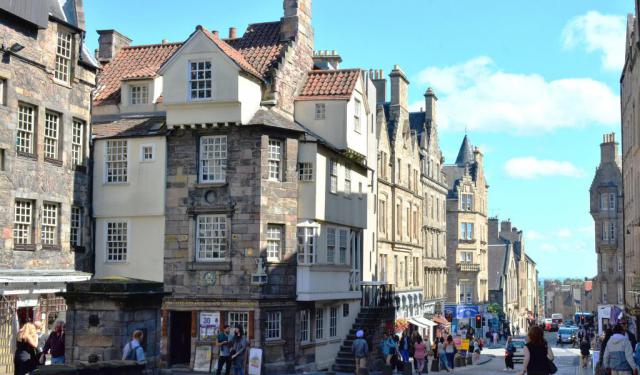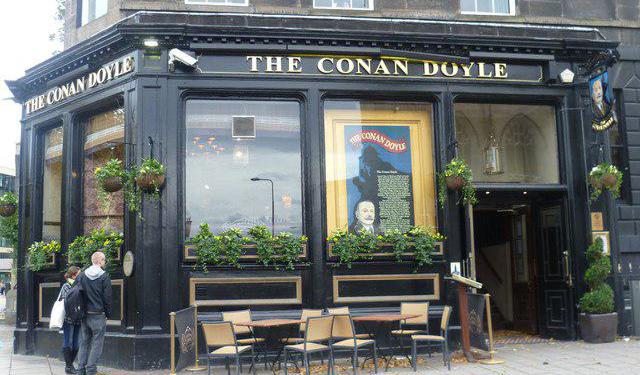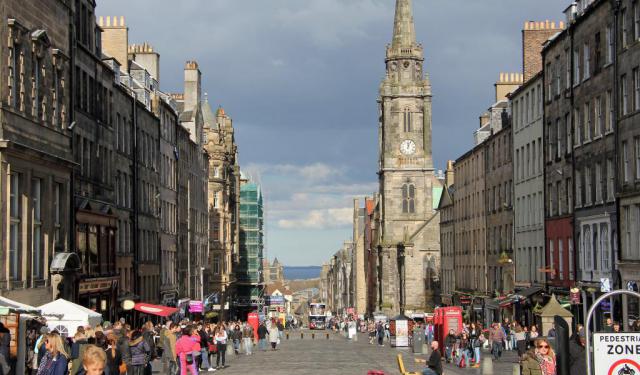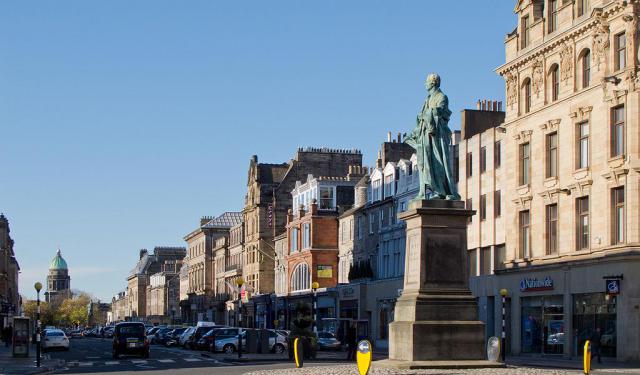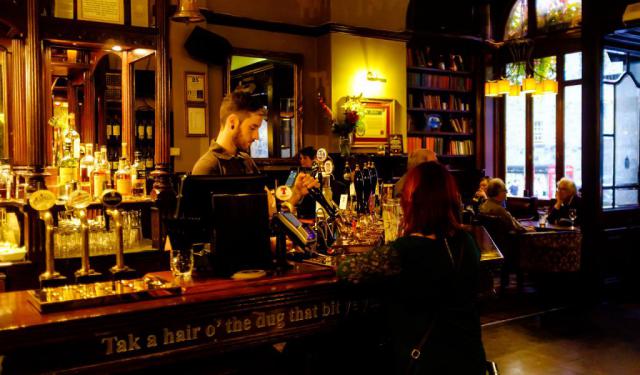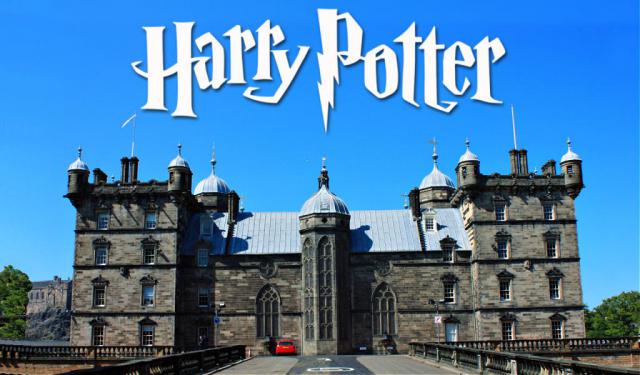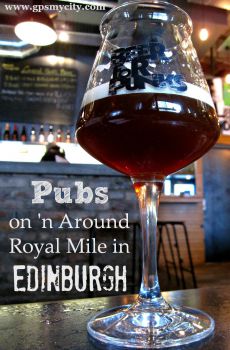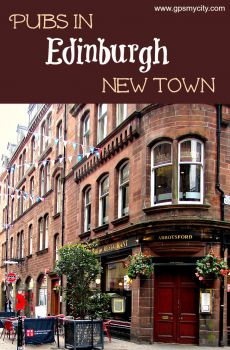Audio Guide: Edinburgh Introduction Walking Tour (Self Guided), Edinburgh
If you like cities with a split personality, Edinburgh is definitely one such, featuring a striking mix of medieval and Georgian architecture. Indeed, here medieval grit meets Enlightenment wit, and every cobbled incline has a story to tell-whether your legs are ready for it or not. Perched (or more like wedged) across volcanic hills, the city has been Scotland’s capital since the 15th century and the official home of the Scottish Parliament since 1999.
The area itself has been welcoming humans since around 8500 BC. King David I gave the place a royal promotion in the 12th century, founding a fortress that, by the 1400s, was already being called “the principal stronghold of the kingdom.” Modest, it was not. Referring to it is the city's name, which comes from the Old English “Eiden’s Burh,” meaning the “fort of Eidyn” (which is the name for the region in the Brittonic Celtic language formerly spoken here).
Skip ahead to the 1700s, and things got... slightly aromatic. Edinburgh had become one of Europe’s most overcrowded and unhygienic cities-a fragrant blend of brilliance and stench. But even through the grime, the city lit up intellectually, birthing the Scottish Enlightenment and becoming a playground for thinkers like Adam Smith. So, yes, it smelled a bit off, but it thought very deeply. Hence the nickname: “Athens of the North”-minus the togas...
Unlike its soot-covered cousins down south, Edinburgh didn’t industrialize as heavily as other British cities in the 19th century. Instead, it focused on growing its commercial heart between Princes Street and George Street, giving rise to the shopping core we know today. The Victorian facelift began in the 1860s, followed by fits and starts of urban cleanup. By the 1960s and 70s, the city had finally declared war on slums, slowly polishing its Old Town into something tour-bus ready.
Then came the 1990s, when a shiny new financial district sprouted, helping Edinburgh cement its status as the UK’s second biggest money-and-paperwork hub after London. Add in national treasures like the Scottish National Gallery, Edinburgh Castle lording over the skyline, Holyrood Palace glamming up the Royal Mile, the Gothic flair of St. Giles’ Cathedral, and more picturesque stones than your camera roll can handle, and you’ve got a city pulling double duty as both cultural heavyweight and tourist magnet-drawing in over 4 million curious souls a year.
Ready to meet these and other attractions in person? Great-lace up your boots (or at least tighten your laces) and let this self-guided walk be your backstage pass to a city that’s equal parts brooding, brilliant, and occasionally tipsy.
The area itself has been welcoming humans since around 8500 BC. King David I gave the place a royal promotion in the 12th century, founding a fortress that, by the 1400s, was already being called “the principal stronghold of the kingdom.” Modest, it was not. Referring to it is the city's name, which comes from the Old English “Eiden’s Burh,” meaning the “fort of Eidyn” (which is the name for the region in the Brittonic Celtic language formerly spoken here).
Skip ahead to the 1700s, and things got... slightly aromatic. Edinburgh had become one of Europe’s most overcrowded and unhygienic cities-a fragrant blend of brilliance and stench. But even through the grime, the city lit up intellectually, birthing the Scottish Enlightenment and becoming a playground for thinkers like Adam Smith. So, yes, it smelled a bit off, but it thought very deeply. Hence the nickname: “Athens of the North”-minus the togas...
Unlike its soot-covered cousins down south, Edinburgh didn’t industrialize as heavily as other British cities in the 19th century. Instead, it focused on growing its commercial heart between Princes Street and George Street, giving rise to the shopping core we know today. The Victorian facelift began in the 1860s, followed by fits and starts of urban cleanup. By the 1960s and 70s, the city had finally declared war on slums, slowly polishing its Old Town into something tour-bus ready.
Then came the 1990s, when a shiny new financial district sprouted, helping Edinburgh cement its status as the UK’s second biggest money-and-paperwork hub after London. Add in national treasures like the Scottish National Gallery, Edinburgh Castle lording over the skyline, Holyrood Palace glamming up the Royal Mile, the Gothic flair of St. Giles’ Cathedral, and more picturesque stones than your camera roll can handle, and you’ve got a city pulling double duty as both cultural heavyweight and tourist magnet-drawing in over 4 million curious souls a year.
Ready to meet these and other attractions in person? Great-lace up your boots (or at least tighten your laces) and let this self-guided walk be your backstage pass to a city that’s equal parts brooding, brilliant, and occasionally tipsy.
How it works: Download the app "GPSmyCity: Walks in 1K+ Cities" from Apple App Store or Google Play Store to your mobile phone or tablet. The app turns your mobile device into a personal tour guide and its built-in GPS navigation functions guide you from one tour stop to next. The app works offline, so no data plan is needed when traveling abroad.
Edinburgh Introduction Walking Tour Map
Guide Name: Edinburgh Introduction Walking Tour
Guide Location: Scotland » Edinburgh (See other walking tours in Edinburgh)
Guide Type: Self-guided Walking Tour (Sightseeing)
# of Attractions: 14
Tour Duration: 2 Hour(s)
Travel Distance: 3.4 Km or 2.1 Miles
Author: DanaOffice
Sight(s) Featured in This Guide:
Guide Location: Scotland » Edinburgh (See other walking tours in Edinburgh)
Guide Type: Self-guided Walking Tour (Sightseeing)
# of Attractions: 14
Tour Duration: 2 Hour(s)
Travel Distance: 3.4 Km or 2.1 Miles
Author: DanaOffice
Sight(s) Featured in This Guide:
- Edinburgh Castle
- Scotch Whisky Experience
- Camera Obscura and World of Illusions
- Scottish National Gallery
- Princes Street Gardens
- Princes Street
- Scott Monument
- St. Giles' Cathedral
- Mary King's Close
- John Knox House
- Museum of Edinburgh
- Scottish Parliament Building
- Holyroodhouse
- Holyrood Abbey
1) Edinburgh Castle (must see)
Edinburgh Castle, looming large over the Scottish capital, is the second most visited attraction in the UK (after the Tower of London, which is still number one). The history of Scotland is deeply etched into its ancient stones, making it a timeline in fortress form.
Perched atop Castle Rock (a hardened basaltic plug from an extinct volcano eroded by glaciers), this area has been drawing humans since the 9th millennium BC. The first castle on the site was built in the 12th century by King David I. It remained a royal residence until 1603, when the monarchy packed up and moved to London-presumably for better weather and indoor plumbing...
Indeed, as a fortress, it was virtually impregnable, except for one major-geological-drawback: the basalt rock on which it stands doesn’t hold water (literally). The 28-meter-deep well inside the fortress was about as useful as a chocolate teapot during a siege. So, when the well ran dry, surrender-or dehydration-was the only choice for those inside.
The original castle was mostly destroyed during the Lang Siege of 1573. The only remainder from its early days is St. Margaret’s Chapel. By the 17th century, it had shifted from royal digs to military barracks, housing troops up to the 1920s.
Presently, the castle hosts the Scottish National War Memorial, the National War Museum, and enough regimental museums to keep military buffs busy till closing time. Don't miss the One O’Clock Gun, which is fired daily (except Sundays) at 1 PM with Swiss-watch precision-yes, Edinburgh literally sets its clocks by it...
Also, in the Crown Room, you will see Scotland’s royal bling-crown, scepter, and sword-resting under heavy guard. Period-costumed actors occasionally swoop in to re-enact history with full flair. And if you’re visiting in August, the Military Tattoo takes over the esplanade with kilts, cannons, and bagpipes galore.
Oh, and in the north-east corner of the esplanade, don't miss that rather unassuming little iron fountain. Called Witches' Well, it marks the spot where, back in the day, many women accused of witchcraft were burned at the stake. Spooky, grim, and sadly true...
The panoramic views are postcard-worthy, the historical nooks are endlessly fascinating, and honestly, it just feels epic to stand where centuries of royals, rebels, and rock-solid drama unfolded.
Pro Tips:
The entry is cheaper, and more importantly, faster, if you book online.
Take a free guided tour – running every hour. Otherwise, consider grabbing the £3 audio guide if you like facts with flair.
Being at the mountain's top, it may get breezy, so definitely bring a windproof jacket if visiting in cold weather.
Perched atop Castle Rock (a hardened basaltic plug from an extinct volcano eroded by glaciers), this area has been drawing humans since the 9th millennium BC. The first castle on the site was built in the 12th century by King David I. It remained a royal residence until 1603, when the monarchy packed up and moved to London-presumably for better weather and indoor plumbing...
Indeed, as a fortress, it was virtually impregnable, except for one major-geological-drawback: the basalt rock on which it stands doesn’t hold water (literally). The 28-meter-deep well inside the fortress was about as useful as a chocolate teapot during a siege. So, when the well ran dry, surrender-or dehydration-was the only choice for those inside.
The original castle was mostly destroyed during the Lang Siege of 1573. The only remainder from its early days is St. Margaret’s Chapel. By the 17th century, it had shifted from royal digs to military barracks, housing troops up to the 1920s.
Presently, the castle hosts the Scottish National War Memorial, the National War Museum, and enough regimental museums to keep military buffs busy till closing time. Don't miss the One O’Clock Gun, which is fired daily (except Sundays) at 1 PM with Swiss-watch precision-yes, Edinburgh literally sets its clocks by it...
Also, in the Crown Room, you will see Scotland’s royal bling-crown, scepter, and sword-resting under heavy guard. Period-costumed actors occasionally swoop in to re-enact history with full flair. And if you’re visiting in August, the Military Tattoo takes over the esplanade with kilts, cannons, and bagpipes galore.
Oh, and in the north-east corner of the esplanade, don't miss that rather unassuming little iron fountain. Called Witches' Well, it marks the spot where, back in the day, many women accused of witchcraft were burned at the stake. Spooky, grim, and sadly true...
The panoramic views are postcard-worthy, the historical nooks are endlessly fascinating, and honestly, it just feels epic to stand where centuries of royals, rebels, and rock-solid drama unfolded.
Pro Tips:
The entry is cheaper, and more importantly, faster, if you book online.
Take a free guided tour – running every hour. Otherwise, consider grabbing the £3 audio guide if you like facts with flair.
Being at the mountain's top, it may get breezy, so definitely bring a windproof jacket if visiting in cold weather.
2) Scotch Whisky Experience (must see)
So, what is the difference between “whisky” and “whiskey”? If that little “e” is driving you to drink, head straight to The Scotch Whisky Experience, where answers-and drams-await. This is Scotland’s answer to Disneyland, but with fewer cartoon mice and significantly more peat smoke.
Indeed, this interactive museum doesn’t just cater to connoisseurs and curious adults. Even the wee (the Scottish word for “little” ones) get a slice of the fun, thanks to “Peat the Cat”-their feline guide through a world of whisky facts and playful games. Meanwhile, the grown-ups hop aboard a moving barrel (yes, you heard that right) for a slow cruise through a mechanical distillery, narrated by none other than the ethereal “Whisky Ghost.” He knows his mash from his malt, and he’s not afraid to share-within reason, of course...
Next stop: the MacIntyre Whisky Gallery, where you'll learn how different flavours are crafted. Well, some of the flavours (trade secrets are revealed only partially...). Then it’s on to the Sense of Scotland room, where your nose gets a full workout sniffing everything from smoky campfires to sweet toffee notes-basically a perfume department for whisky fans.
Your grand finale is the tasting room. Here, you’ll find your whisky-yes, even you who swore you didn’t like the stuff. But do yourself a favour: don’t ask for ice or soda. You’ll get looks colder than the Highlands in January.
Before you stumble out, swing by the gift shop. With over 300 malts and miniatures on offer, it’s practically a whisky library. Tour guests even get a discount-because education should come with perks...
So, in case you're still wondering why go?-Here's the answer: Because where else can you ogle 3,400 unopened bottles of whisky worth a fortune, sip your way through centuries of liquid history, and pair it all with cheese and chocolate that’d make a Highlander weep?
Top Tip:
Spring for the “Gold Tour” if you’re in it for the full whisky safari. And if you're not all that keen on whisky but prefer to look, sniff, and learn without the burn-The “Silver Tour” has your name on it. Slàinte!
Indeed, this interactive museum doesn’t just cater to connoisseurs and curious adults. Even the wee (the Scottish word for “little” ones) get a slice of the fun, thanks to “Peat the Cat”-their feline guide through a world of whisky facts and playful games. Meanwhile, the grown-ups hop aboard a moving barrel (yes, you heard that right) for a slow cruise through a mechanical distillery, narrated by none other than the ethereal “Whisky Ghost.” He knows his mash from his malt, and he’s not afraid to share-within reason, of course...
Next stop: the MacIntyre Whisky Gallery, where you'll learn how different flavours are crafted. Well, some of the flavours (trade secrets are revealed only partially...). Then it’s on to the Sense of Scotland room, where your nose gets a full workout sniffing everything from smoky campfires to sweet toffee notes-basically a perfume department for whisky fans.
Your grand finale is the tasting room. Here, you’ll find your whisky-yes, even you who swore you didn’t like the stuff. But do yourself a favour: don’t ask for ice or soda. You’ll get looks colder than the Highlands in January.
Before you stumble out, swing by the gift shop. With over 300 malts and miniatures on offer, it’s practically a whisky library. Tour guests even get a discount-because education should come with perks...
So, in case you're still wondering why go?-Here's the answer: Because where else can you ogle 3,400 unopened bottles of whisky worth a fortune, sip your way through centuries of liquid history, and pair it all with cheese and chocolate that’d make a Highlander weep?
Top Tip:
Spring for the “Gold Tour” if you’re in it for the full whisky safari. And if you're not all that keen on whisky but prefer to look, sniff, and learn without the burn-The “Silver Tour” has your name on it. Slàinte!
3) Camera Obscura and World of Illusions (must see)
Back in 1835, an entrepreneurial firecracker named Maria Theresa Short decided that Edinburgh needed more science and spectacle. So, she launched what would become the Camera Obscura & World of Illusions, a place where city views met mind-bending visuals long before Instagram filters were a thing.
Short's first venture, called “Short’s Popular Observatory,” was a quirky little spot built from wood, stone, and pure determination up on Calton Hill, near the National Monument. Sadly, the authorities weren’t fans-so, in 1851, they dismantled it. Undeterred, Short relocated to Castlehill, bought the townhouse of the Laird of Cockpen (indeed, this was his name), and stacked two extra floors on top. By 1853, she had rebranded the place as Short’s Observatory, Museum of Science and Art-a title almost as long as the staircase...
In 1892, the venue came under the management of Patrick Geddes, a forward-thinking Scottish urban planner, sociologist, and ecologist, who gave the building a brainy makeover. He renamed it the Outlook Tower and transformed it into a museum and urban study center. In essence, Geddes filled it with a clever vertical geography lesson: the world at the bottom, Europe and English-speaking countries in the middle, and Edinburgh at the top. Crowning it all, in the topmost room, was a Camera Obscura-because, even in the Victorian era, they already wanted something similar to Google Earth!
The museum ceased operations following Geddes' passing in 1932. In 1966, the University of Edinburgh acquired the site with the intention of establishing the Patrick Geddes Centre and archive. However, in 1982, the building changed ownership to private hands, with a one-room tribute to Geddes remaining on the fourth floor. But that's when the real magic was just getting started.
Today, this tower is Edinburgh’s oldest visitor attraction and still the most delightfully dizzying. It features more than 100 interactive exhibits spread across six floors of illusions, holograms, mirror mazes, vortex tunnels, and hands-on wonders. The rooftop terrace is a camera-ready dream with telescopes and skyline views. The original top-floor Camera Obscura is a 19th-century tech marvel that still gives a live, real-time tour of the city below. It's equally educational, entertaining, and just a little surreal-the kind of place where science meets showbiz and your eyeballs never quite know what hit them.
Short's first venture, called “Short’s Popular Observatory,” was a quirky little spot built from wood, stone, and pure determination up on Calton Hill, near the National Monument. Sadly, the authorities weren’t fans-so, in 1851, they dismantled it. Undeterred, Short relocated to Castlehill, bought the townhouse of the Laird of Cockpen (indeed, this was his name), and stacked two extra floors on top. By 1853, she had rebranded the place as Short’s Observatory, Museum of Science and Art-a title almost as long as the staircase...
In 1892, the venue came under the management of Patrick Geddes, a forward-thinking Scottish urban planner, sociologist, and ecologist, who gave the building a brainy makeover. He renamed it the Outlook Tower and transformed it into a museum and urban study center. In essence, Geddes filled it with a clever vertical geography lesson: the world at the bottom, Europe and English-speaking countries in the middle, and Edinburgh at the top. Crowning it all, in the topmost room, was a Camera Obscura-because, even in the Victorian era, they already wanted something similar to Google Earth!
The museum ceased operations following Geddes' passing in 1932. In 1966, the University of Edinburgh acquired the site with the intention of establishing the Patrick Geddes Centre and archive. However, in 1982, the building changed ownership to private hands, with a one-room tribute to Geddes remaining on the fourth floor. But that's when the real magic was just getting started.
Today, this tower is Edinburgh’s oldest visitor attraction and still the most delightfully dizzying. It features more than 100 interactive exhibits spread across six floors of illusions, holograms, mirror mazes, vortex tunnels, and hands-on wonders. The rooftop terrace is a camera-ready dream with telescopes and skyline views. The original top-floor Camera Obscura is a 19th-century tech marvel that still gives a live, real-time tour of the city below. It's equally educational, entertaining, and just a little surreal-the kind of place where science meets showbiz and your eyeballs never quite know what hit them.
4) Scottish National Gallery (must see)
For all art lovers-yes, even the ones who can’t tell a Botticelli from a biscotti (an Italian almond biscuit for those unaware)-the Scottish National Gallery is a must-do cultural pitstop. Perched elegantly on the Mound right next to the Royal Scottish Academy, this temple of fine art has been dazzling eyeballs since 1859. Back then, it was a bit of a packed house: the gallery, the academy, and even the Portrait Gallery all cozied up under one neoclassical roof. Eventually, the Portrait Gallery moved to its new location, and by 1906, the academy shuffled next door too-because elbow room really matters when you’re hanging a Titian...
The gallery was entirely renovated in 1912. Today it boasts a collection of over 30,000 artworks, featuring both Scottish and European art-from Renaissance to Romanticism, with a few moody Impressionists thrown in for flair. Among them are Bassano, Botticelli, Bernini, Cézanne, Degas, da Vinci, and... deep breath... El Greco, Titian, and Tiepolo, too. Want something bolder? Don’t miss Gauguin’s “Vision of the Sermon.” And if you fancy some sculptural marble drama, Canova’s “Three Graces” has you covered.
The gallery also houses the Research Library-one of the world's finest reference libraries-which is a treasure trove of over 50,000 books, journals, and oddities spanning seven centuries from the 1300s. Meanwhile, the Western Link connects the gallery to the academy via a sleek underground space with a lecture theatre, a classy café, and a shop full of irresistible arty bits. Plus, there's an interactive IT Gallery, where, using touch-screens, you can swipe your way through the gallery’s entire collection like a very refined dating app.
So, whenever you feel like getting up close with a da Vinci sketch and still having time for tea, check out this place. It’s free to enter the permanent exhibits, and the cozy layout makes for a perfect rainy-day escape.
Insider tip:
Make sure you visit both the main Gallery and the Academy behind it.
Note the grand Turner watercolor exhibition that goes on show every January-some truly wonderful insights into his travels around Europe. It’s like Europe through the eyes of a genius-with less fog and more flair...
The gallery was entirely renovated in 1912. Today it boasts a collection of over 30,000 artworks, featuring both Scottish and European art-from Renaissance to Romanticism, with a few moody Impressionists thrown in for flair. Among them are Bassano, Botticelli, Bernini, Cézanne, Degas, da Vinci, and... deep breath... El Greco, Titian, and Tiepolo, too. Want something bolder? Don’t miss Gauguin’s “Vision of the Sermon.” And if you fancy some sculptural marble drama, Canova’s “Three Graces” has you covered.
The gallery also houses the Research Library-one of the world's finest reference libraries-which is a treasure trove of over 50,000 books, journals, and oddities spanning seven centuries from the 1300s. Meanwhile, the Western Link connects the gallery to the academy via a sleek underground space with a lecture theatre, a classy café, and a shop full of irresistible arty bits. Plus, there's an interactive IT Gallery, where, using touch-screens, you can swipe your way through the gallery’s entire collection like a very refined dating app.
So, whenever you feel like getting up close with a da Vinci sketch and still having time for tea, check out this place. It’s free to enter the permanent exhibits, and the cozy layout makes for a perfect rainy-day escape.
Insider tip:
Make sure you visit both the main Gallery and the Academy behind it.
Note the grand Turner watercolor exhibition that goes on show every January-some truly wonderful insights into his travels around Europe. It’s like Europe through the eyes of a genius-with less fog and more flair...
5) Princes Street Gardens (must see)
Between the volcanic drama of Edinburgh Castle and the shopping temptation of Princes Street, you'll stumble across a surprisingly serene stretch of green: Princes Street Gardens. Yes, in a city built on myth, mist, and medieval grit, here's your central patch of peace-complete with ducks, monuments, and the occasional bagpiper soundtrack.
Some 110,000 years ago, the area that is now the quiet garden was a glacial accident waiting to happen. As an ancient glacier oozed its way around the hulking basalt of Castle Rock, it carved out a natural dip-basically scooping out what would later become, and for thousands of years remained, a marshy, defensive moat at the foot of Castle Rock. Humans started settling here by the 9th century BC, presumably appreciating the defensive perks and the view.
Then, in 1460, King James III ordered the marsh to be flooded, turning it into Nor Loch-a grim, murky moat that made invading Edinburgh Castle even less appealing. Further ahead, in 1759, the loch was drained to make way for the New Town. Even today, this area still occasionally gets flooded.
When construction on the New Town kicked off, a handy solution for all that leftover dirt (some millions of tons of earth) was to dump it into the former loch. And thus the Mound, upon which many prestigious buildings stand today, was born. By 1820, the area was transformed into Princes Street Gardens: 8.5 acres to the east and 29 acres to the west, flanking The Mound like leafy bookends.
The gardens now come with a side of Scottish fame. The towering Scott Monument takes center stage, joined by statues of local legends like author John Wilson, Christian missionary David Livingstone, and poet Allan Ramsay. There’s a playground for kids, shade under grand trees, countless benches for people-watching, and even a café if you need caffeine with your contemplation.
In December, this peaceful patch gets seriously festive, with carnival rides, mulled wine, twinkling lights, Edinburgh’s main Christmas Market, and even an ice rink-because few things can contribute to a “holiday spirit” as greatly as skating under a Gothic spire!
Some 110,000 years ago, the area that is now the quiet garden was a glacial accident waiting to happen. As an ancient glacier oozed its way around the hulking basalt of Castle Rock, it carved out a natural dip-basically scooping out what would later become, and for thousands of years remained, a marshy, defensive moat at the foot of Castle Rock. Humans started settling here by the 9th century BC, presumably appreciating the defensive perks and the view.
Then, in 1460, King James III ordered the marsh to be flooded, turning it into Nor Loch-a grim, murky moat that made invading Edinburgh Castle even less appealing. Further ahead, in 1759, the loch was drained to make way for the New Town. Even today, this area still occasionally gets flooded.
When construction on the New Town kicked off, a handy solution for all that leftover dirt (some millions of tons of earth) was to dump it into the former loch. And thus the Mound, upon which many prestigious buildings stand today, was born. By 1820, the area was transformed into Princes Street Gardens: 8.5 acres to the east and 29 acres to the west, flanking The Mound like leafy bookends.
The gardens now come with a side of Scottish fame. The towering Scott Monument takes center stage, joined by statues of local legends like author John Wilson, Christian missionary David Livingstone, and poet Allan Ramsay. There’s a playground for kids, shade under grand trees, countless benches for people-watching, and even a café if you need caffeine with your contemplation.
In December, this peaceful patch gets seriously festive, with carnival rides, mulled wine, twinkling lights, Edinburgh’s main Christmas Market, and even an ice rink-because few things can contribute to a “holiday spirit” as greatly as skating under a Gothic spire!
6) Princes Street
Stretching from Leith Street to Lothian Road like Edinburgh’s own stylish catwalk, Princes Street is an over-a-mile-long stretch of shopping temptation-the city’s main artery, buzzing with cafés, pubs, department stores, and selfie opportunities galore.
The street was named after two of King George III’s sons-Prince George (who later became King George IV) and Prince Frederick. While the early 18th-century buildings once stood prim and proper, the 19th century and later the 1960s had other plans. Cue the “Princes Street Plan,” a bold makeover that saw some old façades pulled down in favor of boxy modern storefronts, all in the name of progress and window-shopping efficiency.
The resulting new layout appears as follows: shops and commercial buzz line the north side, while the south side takes the scenic route, offering unbeatable views of the Old Town and the ever-dramatic Edinburgh Castle. Between them lies what was once a murky loch-or Nor Loch to be exact-drained in 1820 and transformed into the much more appealing Princes Street Gardens.
The gardens span 38 acres of greenery, split neatly by the Mound and sprinkled with statues like an outdoor sculpture gallery. One especially moving highlight is the War Memorial to Scottish-American soldiers, a spot for reflection amid the buskers and picnic blankets.
In the summer, the Ross Bandstand kicks into gear with concerts and open-air theatre. And don’t miss the city’s prettiest timekeeper-a floral clock that blooms right on cue.
The street was named after two of King George III’s sons-Prince George (who later became King George IV) and Prince Frederick. While the early 18th-century buildings once stood prim and proper, the 19th century and later the 1960s had other plans. Cue the “Princes Street Plan,” a bold makeover that saw some old façades pulled down in favor of boxy modern storefronts, all in the name of progress and window-shopping efficiency.
The resulting new layout appears as follows: shops and commercial buzz line the north side, while the south side takes the scenic route, offering unbeatable views of the Old Town and the ever-dramatic Edinburgh Castle. Between them lies what was once a murky loch-or Nor Loch to be exact-drained in 1820 and transformed into the much more appealing Princes Street Gardens.
The gardens span 38 acres of greenery, split neatly by the Mound and sprinkled with statues like an outdoor sculpture gallery. One especially moving highlight is the War Memorial to Scottish-American soldiers, a spot for reflection amid the buskers and picnic blankets.
In the summer, the Ross Bandstand kicks into gear with concerts and open-air theatre. And don’t miss the city’s prettiest timekeeper-a floral clock that blooms right on cue.
7) Scott Monument (must see)
Sir Walter Scott-Scotland’s literary darling, national treasure, and master of the pen-was so loved by the country that they figured one statue for him wasn't enough. Instead, they built him a giant Gothic spire right in Princes Street Gardens-the Scott Monument. Because, indeed, what better way to honour a writer than with a stone rocket aimed at the heavens?
When Scott passed away in 1832, the city held a grand design competition for his monument. Out of the great many prestigious architects who entered, the winning design came from... a draughtsman with zero architectural credentials. George Meikle Kemp, feeling cheeky, submitted his entry under the pseudonym “John Morvo,” borrowing the name of a 15th-century stonemason to boost his street cred. And it worked.
Now, if you’re up for a challenge, you can tackle the 61-metre-tall monument that has several viewing platforms accessed by narrow winding stairways. The highest of them is only 287 steps away. Yes, 287. But rest assured-if your legs don’t give out en route to the top, you’ll be rewarded with sweeping city views and an actual certificate for surviving the climb. Bragging rights included.
The whole structure is made of Binny Sandstone, a material with a peculiar talent: it is so oily that it attracts dirt almost immediately. Just one year after its completion, the monument looked like it had been standing there for centuries. American writer Bill Bryson once lovingly described it as a “Gothic rocket-ship”-which, honestly, is spot-on.
Inside the base, you’ll find a marble statue of Sir Walter himself, complete with quill, paper, and his loyal dog Maida. Scattered across the monument are 64 statues of characters from his novels, plus a healthy dose of grotesques-those wonderfully creepy Gothic faces that the architect deliberately added to his design to make the monument look more “ancient” and moodier than it is.
For the ease of it, you can admire the monument casually from the safety of the grass. Otherwise, go full adventurer and climb for a 360-degree panoramic view-just don’t expect a lift-and note a fee attached to that.
Tip:
The staircase gets narrow and twisty, and yes, you’ll likely meet people coming down as you're going up. Not particularly recommended for the fainthearted... or the claustrophobic.
When Scott passed away in 1832, the city held a grand design competition for his monument. Out of the great many prestigious architects who entered, the winning design came from... a draughtsman with zero architectural credentials. George Meikle Kemp, feeling cheeky, submitted his entry under the pseudonym “John Morvo,” borrowing the name of a 15th-century stonemason to boost his street cred. And it worked.
Now, if you’re up for a challenge, you can tackle the 61-metre-tall monument that has several viewing platforms accessed by narrow winding stairways. The highest of them is only 287 steps away. Yes, 287. But rest assured-if your legs don’t give out en route to the top, you’ll be rewarded with sweeping city views and an actual certificate for surviving the climb. Bragging rights included.
The whole structure is made of Binny Sandstone, a material with a peculiar talent: it is so oily that it attracts dirt almost immediately. Just one year after its completion, the monument looked like it had been standing there for centuries. American writer Bill Bryson once lovingly described it as a “Gothic rocket-ship”-which, honestly, is spot-on.
Inside the base, you’ll find a marble statue of Sir Walter himself, complete with quill, paper, and his loyal dog Maida. Scattered across the monument are 64 statues of characters from his novels, plus a healthy dose of grotesques-those wonderfully creepy Gothic faces that the architect deliberately added to his design to make the monument look more “ancient” and moodier than it is.
For the ease of it, you can admire the monument casually from the safety of the grass. Otherwise, go full adventurer and climb for a 360-degree panoramic view-just don’t expect a lift-and note a fee attached to that.
Tip:
The staircase gets narrow and twisty, and yes, you’ll likely meet people coming down as you're going up. Not particularly recommended for the fainthearted... or the claustrophobic.
8) St. Giles' Cathedral (must see)
Smack in the middle of the Royal Mile, St Giles’ Cathedral-otherwise known as the High Kirk (or High Church) of Edinburgh-isn't one to be missed. The original building went up in the 12th century but didn’t survive a nasty fire-only the central pillars lived to tell the tale. The replacement was built in 1385. Over the years, it had numerous chapels added-known as aisles-resulting in a kind of charming architectural chaos. At one point, the church had over 50 side altars, like a medieval supermarket of holiness...
In 1466, St Giles’ became a collegiate church, which, in 1490, saw the now-iconic, crown-shaped lantern tower completed. During the Reformation, in 1560, things got a bit dramatic. Most of the church’s treasures vanished-stolen, sold, or just spirited away-including its star relic: Saint Giles’ withered arm and hand, complete with a diamond ring on one skeletal finger (macabre bling at its finest...). In addition to that, the church was partitioned by walls into multiple preaching zones-a kind of Protestant “feng shui,” if you will...
Despite being called a cathedral, it only technically wore that title twice, briefly, during the 17th-century Bishop Wars. The statute of “High Kirk” remains its real claim to fame. A 19th-century restoration gave the church a glow-up-partitions were removed and several chapels pulled down. Among the surviving chapels, perhaps the most beautiful is the Thistle Chapel from 1911: a jaw-dropping High Gothic gem dripping in wood and stone carvings, fluttering heraldic banners, and a breathtaking, delicately carved vaulted ceiling.
Once here, look out for a bronze plaque to Robert Louis Stevenson, author of Treasure Island, in the Moray Aisle, a marble tribute to the dashing but doomed 1st Marquis of Montrose, in the Chapman Aisle, and another to his bitter rival, Archibald Campbell, the 1st Marquis of Argyll, in the Saint Eloi Aisle. Fun fact: these two, once the main signatories of the National Covenant in 1638 (the document signed to oppose attempts to impose Anglican religious practices on the Church of Scotland), became sworn enemies towards the end of their lives. Edinburgh drama, anyone?
Aside from all that, the place is absolutely gorgeous, packed to the rim with stained glass beauty. You’ll walk out with neck cramp from all the ceiling admiration-and it’ll be worth it.
Pro tips:
Entry is free or by donation, but if you’re planning a photo shoot, prepare to fork over £2 for a "permit".
Best to get onto a tour, as there's much you could miss just wandering on your own. Also, if you're feeling adventurous, take the rooftop tour (worth £6).
And yes-don't miss a cozy café downstairs that serves tasty bites. Praise be!
In 1466, St Giles’ became a collegiate church, which, in 1490, saw the now-iconic, crown-shaped lantern tower completed. During the Reformation, in 1560, things got a bit dramatic. Most of the church’s treasures vanished-stolen, sold, or just spirited away-including its star relic: Saint Giles’ withered arm and hand, complete with a diamond ring on one skeletal finger (macabre bling at its finest...). In addition to that, the church was partitioned by walls into multiple preaching zones-a kind of Protestant “feng shui,” if you will...
Despite being called a cathedral, it only technically wore that title twice, briefly, during the 17th-century Bishop Wars. The statute of “High Kirk” remains its real claim to fame. A 19th-century restoration gave the church a glow-up-partitions were removed and several chapels pulled down. Among the surviving chapels, perhaps the most beautiful is the Thistle Chapel from 1911: a jaw-dropping High Gothic gem dripping in wood and stone carvings, fluttering heraldic banners, and a breathtaking, delicately carved vaulted ceiling.
Once here, look out for a bronze plaque to Robert Louis Stevenson, author of Treasure Island, in the Moray Aisle, a marble tribute to the dashing but doomed 1st Marquis of Montrose, in the Chapman Aisle, and another to his bitter rival, Archibald Campbell, the 1st Marquis of Argyll, in the Saint Eloi Aisle. Fun fact: these two, once the main signatories of the National Covenant in 1638 (the document signed to oppose attempts to impose Anglican religious practices on the Church of Scotland), became sworn enemies towards the end of their lives. Edinburgh drama, anyone?
Aside from all that, the place is absolutely gorgeous, packed to the rim with stained glass beauty. You’ll walk out with neck cramp from all the ceiling admiration-and it’ll be worth it.
Pro tips:
Entry is free or by donation, but if you’re planning a photo shoot, prepare to fork over £2 for a "permit".
Best to get onto a tour, as there's much you could miss just wandering on your own. Also, if you're feeling adventurous, take the rooftop tour (worth £6).
And yes-don't miss a cozy café downstairs that serves tasty bites. Praise be!
9) Mary King's Close (must see)
If ghost stories give you chills in a good way, then Real Mary King’s Close might just be your perfect haunt in Edinburgh. Tucked beneath the Royal Exchange, this underground maze of shadowy alleyways and crumbling tenement rooms has a reputation for being one of the most haunted corners of the city-and in Edinburgh, that’s saying something...
Originally a bustling neighborhood, the close was sealed off after the Great Plague of 1645 rolled into town, carried by flea-infested rats from merchant ships. With zero plumbing and not a bar of soap in sight, these cramped quarters became ground zero for infection. In a desperate attempt to contain the spread, entire blocks-predominantly the poorer areas, including Mary King’s Close-were bricked in as urgent quarantine measures. Legend has it, some unlucky souls were trapped inside at the mercy of plague or starvation... and they never left. At least, not in spirit.
One ghost in particular likes to make her presence known: Annie, a small girl, who is said to have lost her doll-and possibly much more-when the plague swept through. Visitors claim to feel her presence, and many bring her gifts: toys, trinkets, or coins, all of which are passed on to children’s hospitals and local charities. So, even the ghostly get a little goodwill...
The area was uncovered during renovations to the Royal Exchange and was opened to the public in 2003 as a tourist attraction. Since then, costumed guides have been leading brave guests through these 17th-century underground time capsules, sharing tales of the little Annie and Mary King-a respected businesswoman and seamstress after whom it is named-as well as the dark chapters etched into every cobbled corner.
So, if you’re in the mood for a little historical horror with a charitable twist, Mary King’s Close is calling. Just... don’t forget Annie’s doll.
Originally a bustling neighborhood, the close was sealed off after the Great Plague of 1645 rolled into town, carried by flea-infested rats from merchant ships. With zero plumbing and not a bar of soap in sight, these cramped quarters became ground zero for infection. In a desperate attempt to contain the spread, entire blocks-predominantly the poorer areas, including Mary King’s Close-were bricked in as urgent quarantine measures. Legend has it, some unlucky souls were trapped inside at the mercy of plague or starvation... and they never left. At least, not in spirit.
One ghost in particular likes to make her presence known: Annie, a small girl, who is said to have lost her doll-and possibly much more-when the plague swept through. Visitors claim to feel her presence, and many bring her gifts: toys, trinkets, or coins, all of which are passed on to children’s hospitals and local charities. So, even the ghostly get a little goodwill...
The area was uncovered during renovations to the Royal Exchange and was opened to the public in 2003 as a tourist attraction. Since then, costumed guides have been leading brave guests through these 17th-century underground time capsules, sharing tales of the little Annie and Mary King-a respected businesswoman and seamstress after whom it is named-as well as the dark chapters etched into every cobbled corner.
So, if you’re in the mood for a little historical horror with a charitable twist, Mary King’s Close is calling. Just... don’t forget Annie’s doll.
10) John Knox House
If you’ve ever wanted to nose around someone else’s house without feeling guilty, house museums are your perfect excuse. Not only do you get a peek at old furniture trends and fancy ceilings, but you also get a dose of juicy historical gossip. And when it comes to John Knox House on the Royal Mile, the stories are just as layered as the timber beams.
Dating back to around 1490, this charming survivor is the oldest house on the Royal Mile-and it’s not shy about showing off. We’re talking hand-painted ceilings, oak beams that have seen things, and a wooden gallery or two that creak with character. Now owned by the Church of Scotland, it was once home to James Mossman, a royal goldsmith. Given that he fashioned not just one but two crowns-one for Mary, Queen of Scots, and another for her son, King James VI-it’s safe to say that this house has seen some sparkle.
Now, here’s the twist: whether John Knox, the renowned 16th-century Protestant Reformer, himself actually lived here is contested-a kind of Medieval real estate marketing... In the 1700s, the place was severely dilapidated and was saved from demolition by the Society of Antiquaries of Scotland, who casually floated the rumour that this had been Knox’s humble abode. Voilà-instant historical landmark!
Inside, the museum is a magnet for anyone even mildly interested in religious history and the Reformation in particular. There are numerous manuscripts, relics, and even papers Knox himself tucked away in a time capsule. Plus, as part of the Scottish Storytelling Centre, the place brings history alive with costumed guides and interactive exhibits. There’s even a special room for children where they can don a John Knox costume and solve puzzles-because, among many other things, family fun includes dressing up as a 16th-century firebrand...
So, go ahead, walk through the creaky floors, raise an eyebrow at the painted ceilings, and decide for yourself-was this Knox’s house, or just a really good story? Either way, it’s worth stepping inside.
Dating back to around 1490, this charming survivor is the oldest house on the Royal Mile-and it’s not shy about showing off. We’re talking hand-painted ceilings, oak beams that have seen things, and a wooden gallery or two that creak with character. Now owned by the Church of Scotland, it was once home to James Mossman, a royal goldsmith. Given that he fashioned not just one but two crowns-one for Mary, Queen of Scots, and another for her son, King James VI-it’s safe to say that this house has seen some sparkle.
Now, here’s the twist: whether John Knox, the renowned 16th-century Protestant Reformer, himself actually lived here is contested-a kind of Medieval real estate marketing... In the 1700s, the place was severely dilapidated and was saved from demolition by the Society of Antiquaries of Scotland, who casually floated the rumour that this had been Knox’s humble abode. Voilà-instant historical landmark!
Inside, the museum is a magnet for anyone even mildly interested in religious history and the Reformation in particular. There are numerous manuscripts, relics, and even papers Knox himself tucked away in a time capsule. Plus, as part of the Scottish Storytelling Centre, the place brings history alive with costumed guides and interactive exhibits. There’s even a special room for children where they can don a John Knox costume and solve puzzles-because, among many other things, family fun includes dressing up as a 16th-century firebrand...
So, go ahead, walk through the creaky floors, raise an eyebrow at the painted ceilings, and decide for yourself-was this Knox’s house, or just a really good story? Either way, it’s worth stepping inside.
11) Museum of Edinburgh
If you're meandering down the Royal Mile and wondering where to get your history fix with a side of scandal, the Museum of Edinburgh is your spot. Housed in the delightfully crooked 16th-century Huntly House-once the home of the city’s hammer-wielding Guild of Hammermen-this place is Edinburgh’s memory palace, packed with everything from Roman relics to rogue biographies.
Inside, you’ll find numerous silverware that practically glows with civic pride, glassware engraved just down the road in Canongate, some pottery that’s almost too pretty to have survived Scottish winters, and a Sedan chair that reminds us how people once got carried away-literally. There are also clocks so stately they make your smartwatch feel wildly inadequate. And don’t miss the costume corner, where you're invited to play dress-up through the ages. Georgian elegance? Victorian gloom? Just pick your century.
Among the many treasures, you’ll stumble across fragments from a 1st-century Roman settlement dug up in Cramond-yes, the Romans beat the tourists to this small village north-west of Edinburgh by about 2,000 years. You’ll also lay eyes on the original National Covenant (that’s serious ink), James Craig’s neatly sketched vision for the New Town, and even Greyfriars Bobby’s food bowl and collar-proof that loyalty earns you legend status in this city.
There is also a “rogues’ gallery” of sorts, where Edinburgh’s darker side grins back at you. Meet Deacon Brodie, respectable tradesman by day, burglar by night-basically Jekyll and Hyde, with better tailoring. And don’t forget Burke and Hare, the notorious body snatchers who supplied fresh corpses to Dr. Knox of the Medicine University, no questions asked...
So, yes, the Museum of Edinburgh has all the drama, dignity, and delightful weirdness this city’s history has to offer-and then some...
Inside, you’ll find numerous silverware that practically glows with civic pride, glassware engraved just down the road in Canongate, some pottery that’s almost too pretty to have survived Scottish winters, and a Sedan chair that reminds us how people once got carried away-literally. There are also clocks so stately they make your smartwatch feel wildly inadequate. And don’t miss the costume corner, where you're invited to play dress-up through the ages. Georgian elegance? Victorian gloom? Just pick your century.
Among the many treasures, you’ll stumble across fragments from a 1st-century Roman settlement dug up in Cramond-yes, the Romans beat the tourists to this small village north-west of Edinburgh by about 2,000 years. You’ll also lay eyes on the original National Covenant (that’s serious ink), James Craig’s neatly sketched vision for the New Town, and even Greyfriars Bobby’s food bowl and collar-proof that loyalty earns you legend status in this city.
There is also a “rogues’ gallery” of sorts, where Edinburgh’s darker side grins back at you. Meet Deacon Brodie, respectable tradesman by day, burglar by night-basically Jekyll and Hyde, with better tailoring. And don’t forget Burke and Hare, the notorious body snatchers who supplied fresh corpses to Dr. Knox of the Medicine University, no questions asked...
So, yes, the Museum of Edinburgh has all the drama, dignity, and delightful weirdness this city’s history has to offer-and then some...
12) Scottish Parliament Building
Now, here’s a building that’s sparked more heated debates than a family Christmas dinner: the Scottish Parliament Building. Sitting right at the foot of Arthur’s Seat on Holyrood Road, in the middle of a UNESCO World Heritage Site, this bold piece of architecture has been poked, praised, and publicly puzzled over since the day it was announced. Construction began in June 1999, with an initial plan to open in 2001. In reality, however, the doors finally opened only in October 2004, with Queen Elizabeth II doing the honours, and everyone politely pretending not to notice the three-year delay.
The mastermind behind this architectural enigma, spanning 1.6 hectares, was the late Spanish architect Enric Miralles, who set out to fuse Scotland’s landscape, spirit, and capital city into one expressive structure. Think leaf-shaped skylights in the Garden Lobby, sweeping wooden curves, massive abstract windows, and more local stone and oak than a luxury Highland lodge. Inside, you’ll also spot sycamore finishes and views of Holyrood Park that probably cost more than your annual rent.
Public reaction to the Parliament Building was, let’s say, divided: some thought it a poetic blend of nature and democracy; others-a modernist jigsaw someone forgot to finish. But you don’t have to take their word for it-take a guided tour. That way, you’ll get to see the bits the average passerby can’t peek into. And if you’d rather stay outside, the public gardens are open for wandering: wildflowers, shrubs, trees, a water pool, leafy paths, lawns, pathways, and more tranquility than you’d expect from a place where laws are made.
And here’s the twist-after all the initial public grumbling and eye-rolling criticisms from the tabloids, the building went on to scoop up some serious praise. Among the several accolades, it even bagged the prestigious 2005 Stirling Prize. Architectural critic Charles Jencks called it one of the finest pieces of craftsmanship and design Britain has seen in a century. Not too shabby for a structure that once got compared to a broken biscuit tin...
The mastermind behind this architectural enigma, spanning 1.6 hectares, was the late Spanish architect Enric Miralles, who set out to fuse Scotland’s landscape, spirit, and capital city into one expressive structure. Think leaf-shaped skylights in the Garden Lobby, sweeping wooden curves, massive abstract windows, and more local stone and oak than a luxury Highland lodge. Inside, you’ll also spot sycamore finishes and views of Holyrood Park that probably cost more than your annual rent.
Public reaction to the Parliament Building was, let’s say, divided: some thought it a poetic blend of nature and democracy; others-a modernist jigsaw someone forgot to finish. But you don’t have to take their word for it-take a guided tour. That way, you’ll get to see the bits the average passerby can’t peek into. And if you’d rather stay outside, the public gardens are open for wandering: wildflowers, shrubs, trees, a water pool, leafy paths, lawns, pathways, and more tranquility than you’d expect from a place where laws are made.
And here’s the twist-after all the initial public grumbling and eye-rolling criticisms from the tabloids, the building went on to scoop up some serious praise. Among the several accolades, it even bagged the prestigious 2005 Stirling Prize. Architectural critic Charles Jencks called it one of the finest pieces of craftsmanship and design Britain has seen in a century. Not too shabby for a structure that once got compared to a broken biscuit tin...
13) Holyroodhouse (must see)
If you're ticking off Edinburgh landmarks, Holyroodhouse is one you can't skip-not unless you're on the run from the crown... Sitting at the royal end of the Royal Mile, this stately pad is the official Scottish residence of the British monarch and once housed none other than Mary, Queen of Scots. That’s right, drama lives here rent-free...
The whole saga begins with King David I, who founded the nearby Holyrood Abbey in 1128 (after a divine deer encounter, according to legend). A few centuries later, precisely by 1501, a palace was built beside the abbey. Now, calling it a “palace”, back then, was maybe a touch ambitious-a grand country house, more like it, rather than Versailles-but it did get bigger in 1532 and 1536. The property was thoroughly renovated in 1633, only to be trashed when Cromwell’s soldiers used it as barracks and then a fire added insult to injury...
Then came the 1670s, when Sir William Bruce, the architectural fixer of the day, rebuilt the place. The abbey chapel became the Chapel Royal, hosting pious activity until 1768, when the roof rather unceremoniously fell in. More restorations followed after that-first in 1822 for a royal visit, and then again in the 20th century when King George V and Queen Mary decided the palace could really use indoor plumbing. Royal flush, anyone?
When the royals are away, the house is open to the public. Inside, you can marvel at ceiling stucco so delicate it practically whispers, and gawk at an entire lineup of Scottish monarchs-some real, some as fictional as their hairlines-painted by the Dutch Golden Age artist Jacob de Wet. Then, dive into the Royal Collection, a five-century mix of armor, jewels, manuscripts, and silverware. Basically, it’s the attic of your dreams-if your attic had Rembrandts and 17th-century clocks.
Oh, and don’t wander off alone unless you're cool with ghosts. Legend has it that Agnes Sampson, accused of witchcraft and executed in 1592, still makes the occasional appearance here. So, if you feel a chill or hear something whispering about herbal remedies... maybe don’t investigate.
Palace, ghosts, ceilings, swords, and sovereign bling-are all here. Holyroodhouse doesn’t just bring the royal drama-it curates it.
The whole saga begins with King David I, who founded the nearby Holyrood Abbey in 1128 (after a divine deer encounter, according to legend). A few centuries later, precisely by 1501, a palace was built beside the abbey. Now, calling it a “palace”, back then, was maybe a touch ambitious-a grand country house, more like it, rather than Versailles-but it did get bigger in 1532 and 1536. The property was thoroughly renovated in 1633, only to be trashed when Cromwell’s soldiers used it as barracks and then a fire added insult to injury...
Then came the 1670s, when Sir William Bruce, the architectural fixer of the day, rebuilt the place. The abbey chapel became the Chapel Royal, hosting pious activity until 1768, when the roof rather unceremoniously fell in. More restorations followed after that-first in 1822 for a royal visit, and then again in the 20th century when King George V and Queen Mary decided the palace could really use indoor plumbing. Royal flush, anyone?
When the royals are away, the house is open to the public. Inside, you can marvel at ceiling stucco so delicate it practically whispers, and gawk at an entire lineup of Scottish monarchs-some real, some as fictional as their hairlines-painted by the Dutch Golden Age artist Jacob de Wet. Then, dive into the Royal Collection, a five-century mix of armor, jewels, manuscripts, and silverware. Basically, it’s the attic of your dreams-if your attic had Rembrandts and 17th-century clocks.
Oh, and don’t wander off alone unless you're cool with ghosts. Legend has it that Agnes Sampson, accused of witchcraft and executed in 1592, still makes the occasional appearance here. So, if you feel a chill or hear something whispering about herbal remedies... maybe don’t investigate.
Palace, ghosts, ceilings, swords, and sovereign bling-are all here. Holyroodhouse doesn’t just bring the royal drama-it curates it.
14) Holyrood Abbey
If you wander to the far end of Edinburgh’s Royal Mile, you’ll stumble upon the hauntingly beautiful remains of Holyrood Abbey-an epic blend of crumbled stone, royal drama, and deer-related miracles. Founded in 1128 by King David I, the abbey takes its name from an old Scottish term for the "Holy Cross" on which Jesus was crucified. Legend says that the king had a brush with death while hunting when a stag with a glowing crucifix between its antlers (or maybe just a particularly shiny sun reflection) charged him. Divine intervention or optical illusion, but the king took it as a holy sign and built an abbey right there in gratitude.
The original abbey evolved a lot over the years. Between 1195 and 1230, it went from simple sanctuary to Gothic grandeur. It played host to more than just monks, housing royal ceremonies, meetings of the Scottish Parliament, and even seeing the signing of the Treaty of Edinburgh-Northampton in 1328, which ended the First War of Scottish Independence. So yes, this abbey has receipts.
Charles I had the place spruced up in 1633 for his Scottish coronation, but things went downhill after 1688, when a post-Glorious-Revolution mob gave the building a not-so-glorious makeover, desecrating it. By 1768, the roof had given up entirely and collapsed, turning the abbey into the picturesque ruin it is today. Restoration plans have come and gone, but so far, Holyrood Abbey remains roofless and moody-just how romantics like it.
Right next door is the Palace of Holyroodhouse, and surrounding it all is Holyrood Park-home to Arthur’s Seat, scenic trails, and a recurring cast of joggers, photographers, and mildly confused tourists.
The original abbey evolved a lot over the years. Between 1195 and 1230, it went from simple sanctuary to Gothic grandeur. It played host to more than just monks, housing royal ceremonies, meetings of the Scottish Parliament, and even seeing the signing of the Treaty of Edinburgh-Northampton in 1328, which ended the First War of Scottish Independence. So yes, this abbey has receipts.
Charles I had the place spruced up in 1633 for his Scottish coronation, but things went downhill after 1688, when a post-Glorious-Revolution mob gave the building a not-so-glorious makeover, desecrating it. By 1768, the roof had given up entirely and collapsed, turning the abbey into the picturesque ruin it is today. Restoration plans have come and gone, but so far, Holyrood Abbey remains roofless and moody-just how romantics like it.
Right next door is the Palace of Holyroodhouse, and surrounding it all is Holyrood Park-home to Arthur’s Seat, scenic trails, and a recurring cast of joggers, photographers, and mildly confused tourists.
Walking Tours in Edinburgh, Scotland
Create Your Own Walk in Edinburgh
Creating your own self-guided walk in Edinburgh is easy and fun. Choose the city attractions that you want to see and a walk route map will be created just for you. You can even set your hotel as the start point of the walk.
Old Town Walking Tour
Edinburgh’s Old Town isn’t just old-it’s ancient, smoky, and proud of itself. This is the city’s historic core, where centuries of drama, diplomacy, and architectural ambition come layered in stone, soot, and scandal. From its Celtic roots to Roman incursions and royal power plays, this part of town has seen more plot twists than a binge-worthy period drama.
At the heart of it all lies... view more
Tour Duration: 2 Hour(s)
Travel Distance: 2.5 Km or 1.6 Miles
At the heart of it all lies... view more
Tour Duration: 2 Hour(s)
Travel Distance: 2.5 Km or 1.6 Miles
Literary Landmarks Tour
For centuries, Edinburgh has been home to numerous writers. The likes of Robert Burns, Robert Louis Stevenson, and JK Rowling, just to name a few, have given pride to this city. Fortunately, the tradition doesn't seem to die out any time soon, as Edinburgh keeps producing more and more authors and literary heroes in whose footsteps people still wish to tread.
Naturally, there is a wealth... view more
Tour Duration: 1 Hour(s)
Travel Distance: 2.9 Km or 1.8 Miles
Naturally, there is a wealth... view more
Tour Duration: 1 Hour(s)
Travel Distance: 2.9 Km or 1.8 Miles
Royal Mile Walking Tour
The Royal Mile, a steep thoroughfare in the heart of Edinburgh, has served as the city’s backbone since the medieval period. Carved along a volcanic ridge called Castle Rock, this spine of the Old Town slopes down from the mighty Edinburgh Castle at one end to the Holyroodhouse Palace and the weathered ruins of Holyrood Abbey at the other. The distance is almost exactly one Scots mile (hence the... view more
Tour Duration: 2 Hour(s)
Travel Distance: 1.6 Km or 1 Miles
Tour Duration: 2 Hour(s)
Travel Distance: 1.6 Km or 1 Miles
New Town Walking Tour
Rightly regarded as the historic masterpiece of city planning, the New Town of Edinburgh has been a UNESCO World Heritage Site since 1995. The area forms a significant part of the Scottish capital and is known for its elegant Georgian architecture, abundant shopping opportunities, and many other delights firmly associated with this city.
One of the prominent landmarks in the New Town is... view more
Tour Duration: 2 Hour(s)
Travel Distance: 2.5 Km or 1.6 Miles
One of the prominent landmarks in the New Town is... view more
Tour Duration: 2 Hour(s)
Travel Distance: 2.5 Km or 1.6 Miles
Edinburgh Pub Crawl
Edinburgh is rich in pubs, both old and new, spoiling their patrons with the best in town drinks and food. Although most traditional pubs in the city are laid back, with a quiet and relaxing atmosphere, some have dance floors and double as nightclubs. This self-guided adventure takes you to several such spots, each with its own story to tell.
Our journey begins at the World's End Pub, a... view more
Tour Duration: 1 Hour(s)
Travel Distance: 1.5 Km or 0.9 Miles
Our journey begins at the World's End Pub, a... view more
Tour Duration: 1 Hour(s)
Travel Distance: 1.5 Km or 0.9 Miles
Harry Potter Trail
Years after the last Harry Potter book hit the shelves and the last movie rolled its credits, the cultural phenomenon of Harry Potter doesn't seem to fade away, and the fandom continues strong as ever. Although by now Harry Potter has become a household name across the globe, his literary roots are right here in Edinburgh.
Indeed, J.K. Rowling wrote much of the saga in Scotland’s... view more
Tour Duration: 2 Hour(s)
Travel Distance: 2.6 Km or 1.6 Miles
Indeed, J.K. Rowling wrote much of the saga in Scotland’s... view more
Tour Duration: 2 Hour(s)
Travel Distance: 2.6 Km or 1.6 Miles
Useful Travel Guides for Planning Your Trip
Scottish Souvenirs: 15 Authentic Scottish Things to Buy in Edinburgh
The popularity of Scotland stretches far beyond its geographical borders, fueled, in large part, by Hollywood's interest in the Scottish theme - Sean Connery (as James Bond), "Braveheart", etc. Indeed, the cultural spectrum of this part of Britain is enormous and comprises great...
Top 12 Pubs On and Around Royal Mile in Edinburgh
Edinburgh is a vibrant city with abundant nightlife and no shortage of places to go after dusk. The Royal Mile alone, in the very heart of Edinburgh, is laden with character spots craving to be discovered by the first time visitors to the city. This is the highlight of some of the most notable bars...
19 Best Pubs in New Town, Edinburgh
A guide to the pubs that make up the area that is called Edinburgh's New Town. A description about what you can expect from each of the locations in the directory. A fantastic directory if you are a tourist or even a...
The Most Popular Cities
/ view all
